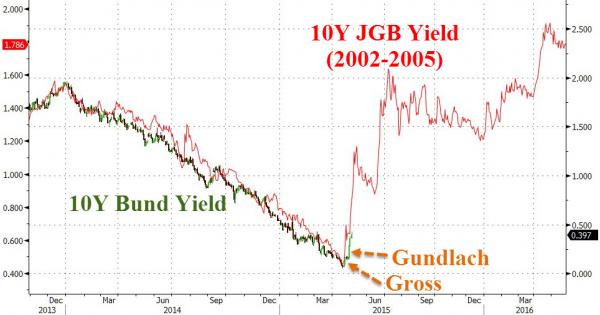10Y German bond yields hit 42.5bps today (almost a 10x move off their 4.9bps lows on April 17th – before Bill Gross and Jeff Gundlach unleashed their bearish theses). While Draghi keeps buying, the move over the last week is ‘almost’ unprecedented in bond market history. We says ‘almost’ because we have seen this before – a sovereign issuer with an extremely low yielding bond suddenly see their bond market collapse… Japan 2003 (when Greenspan cut rates less than expected).

Think this time is different? Think again…
Still in early May 2003, Greenspan and other Fed governors were making public speeches on the possible outbreak of deflation, promising extraordinary measures of liquidity pumping to fight it, including direct purchases of long-term government bonds by the Fed. In its official release following the May 6 Federal Open Market Committee (FOMC) meeting, the Fed said that over the next quarters, “the probability of an unwelcome substantial fall in inflation, though minor, exceeds that of a pickup in inflation from its already low level.” The foreseeable reaction was yet another frenzy on the bond market, pushing down Treasury yields in mid-June to the lowest levels in half a century.
But suddenly, probably under pressure by the White House to present an upbeat economic outlook, Greenspan changed his line. The first indication for this was the decision by the Fed on June 25 to lower its key interest rates by just 0.25%, not the .50% investors had expected. Bond markets worldwide started to go down. As bond prices fell, bond issuers were forced to promise higher interest rates. Already by July 2, yields for 10-year U.S. Treasuries shot up to 3.64%, compared to the 45-year low of 3.07% reached on June 16.
The repercussions were felt worldwide. Japanese government bonds (JGB) on June 30 suffered their biggest slump in two years. On July 3, a bond auction by the Japanese Finance Ministry drew just half as many bids as the previous sale in June, leading on the same day to the biggest JGB plunge since September 1999. Japanese 10-year bond yields reached a record low of 0.435% on June 12, but by July 3 had shot up to 1.125%. On July 4, the JGB crash continued, driving 10-year yields at one point to 1.40%. Japan has the largest government bond market in the world, with $4.7 trillion in outstanding debt, compared to $3.3 trillion U.S. government bonds. Both the German and the British government bond auctions on July 2 drew the lowest demand in several years.
The bond market decline accelerated when Greenspan testified to Congress on July 15, presenting an inexplicably rosy outlook for the U.S. economy. He enthused about the stimulating effects of the Bush Administration’s tax cuts on top of the Fed’s rate cuts. In sharp contrast to previous statements, he now downplayed the threat of deflation: “The FOMC devoted considerable attention to this subject at its June meeting, examining potentially feasible policy alternatives. However, given the now highly stimulative stance of monetary and fiscal policy and well-anchored inflation expectations, the Committee concluded that economic fundamentals are such that situations requiring special policy actions are most unlikely to arise.” Within hours, Greenspan’s comments triggered the biggest massacre on the bond market since the Long-Term Capital Management collapse in Autumn 1998.







